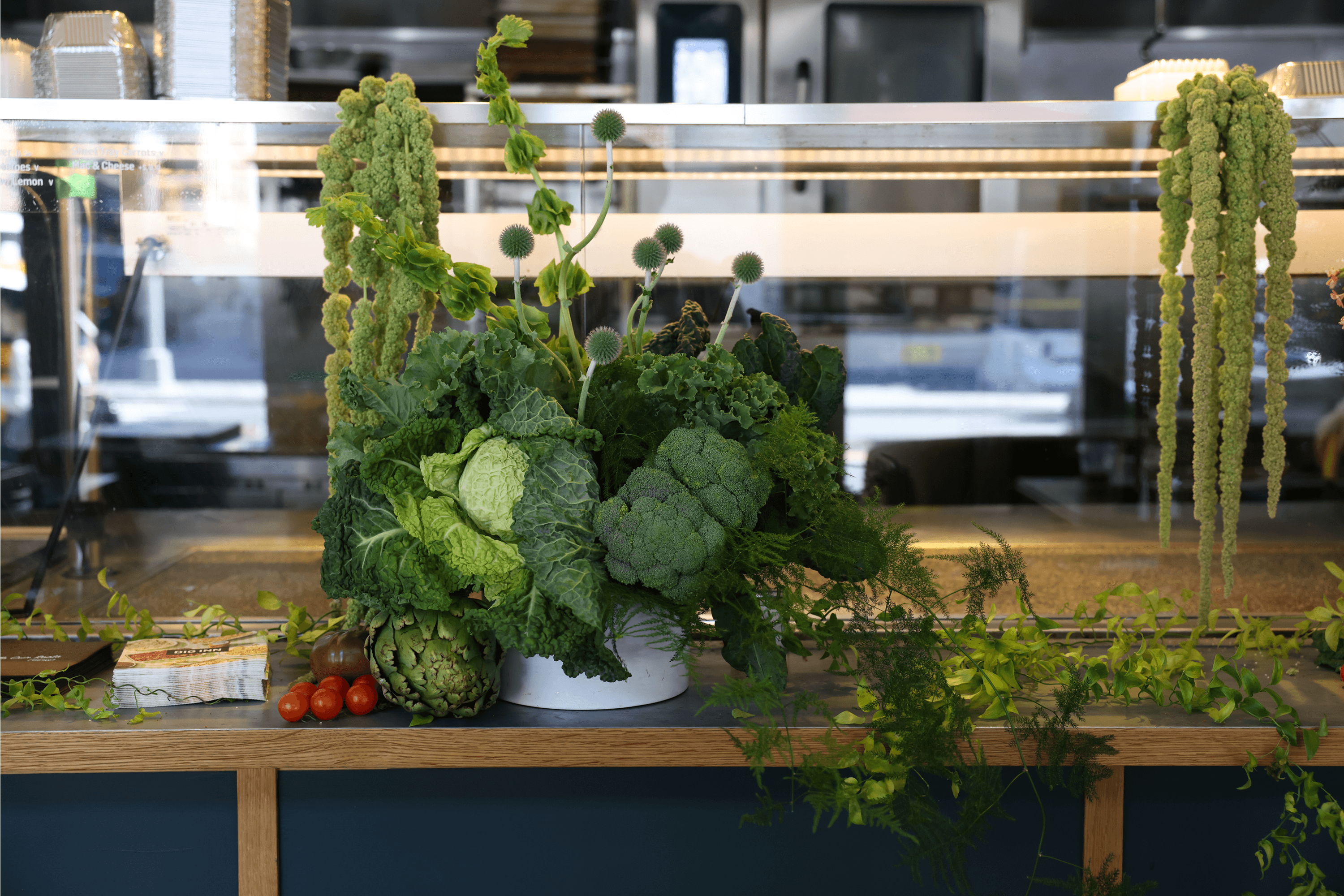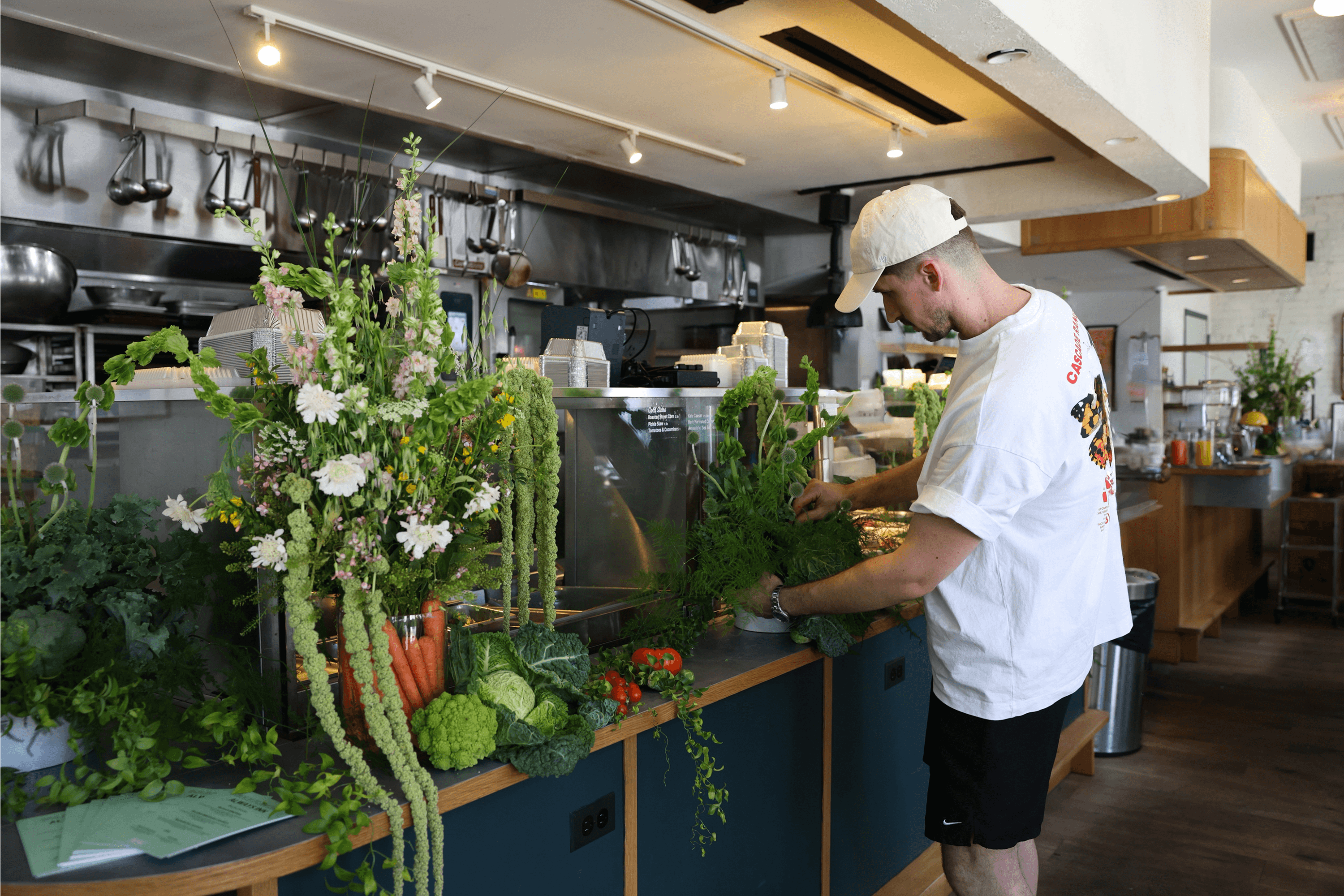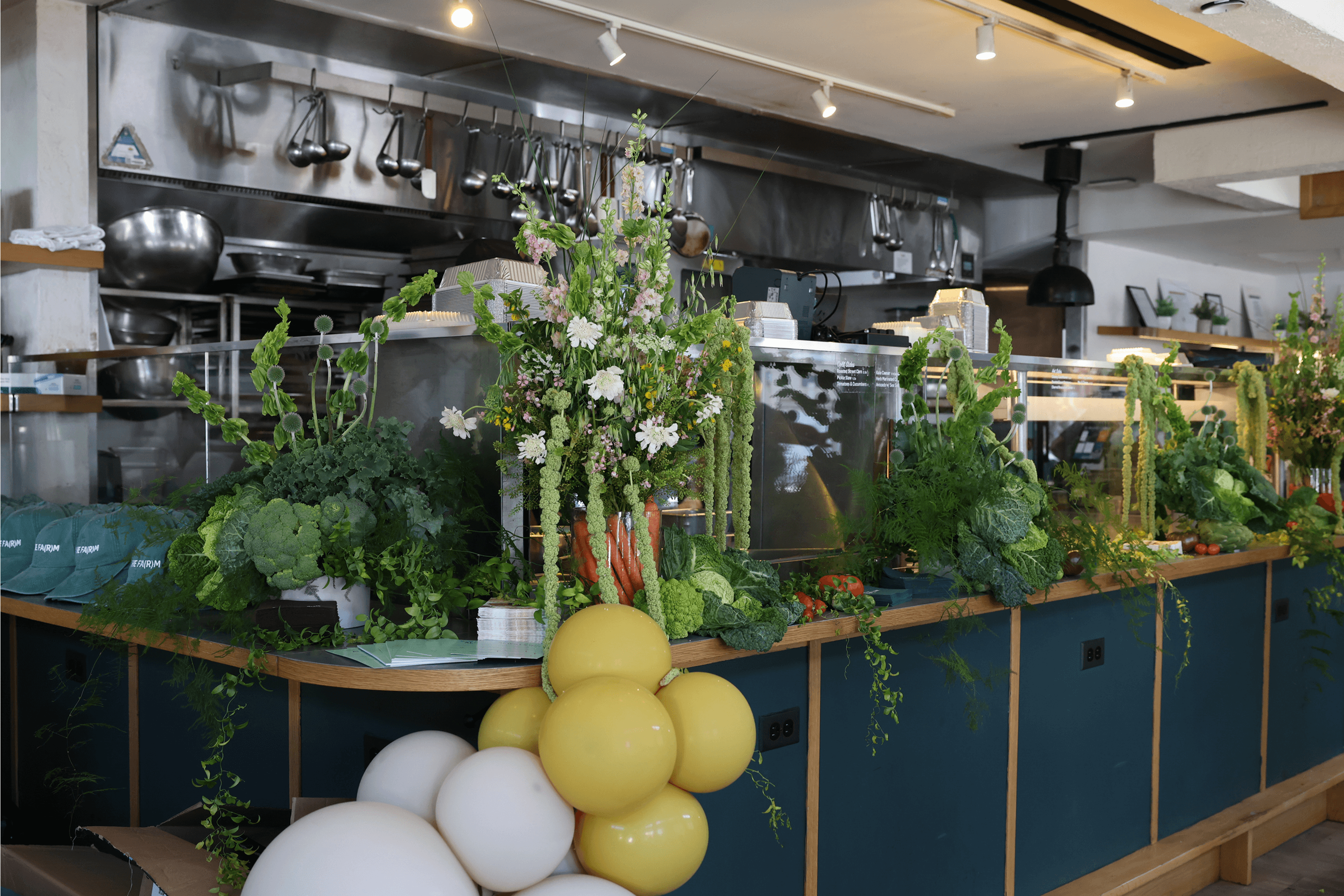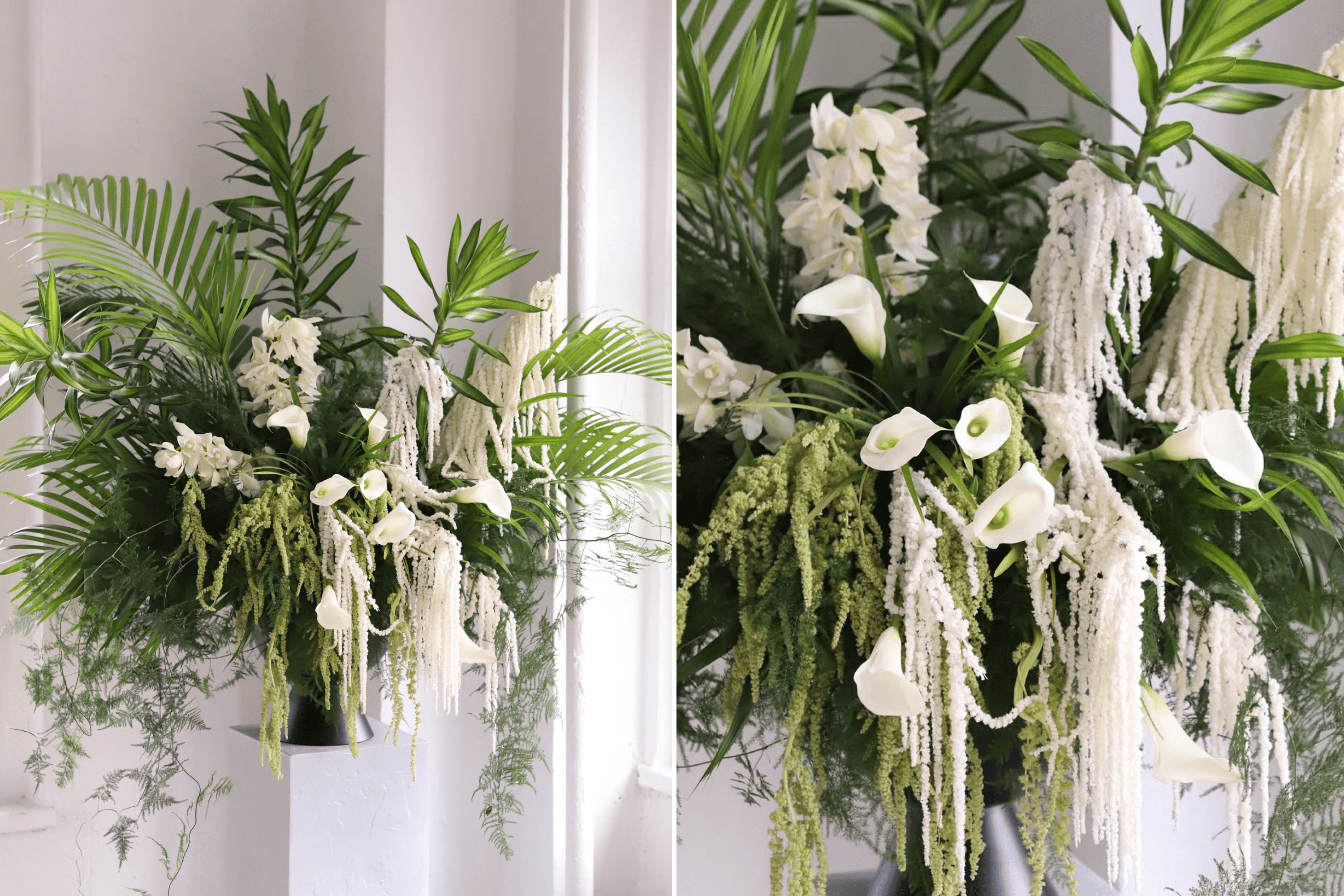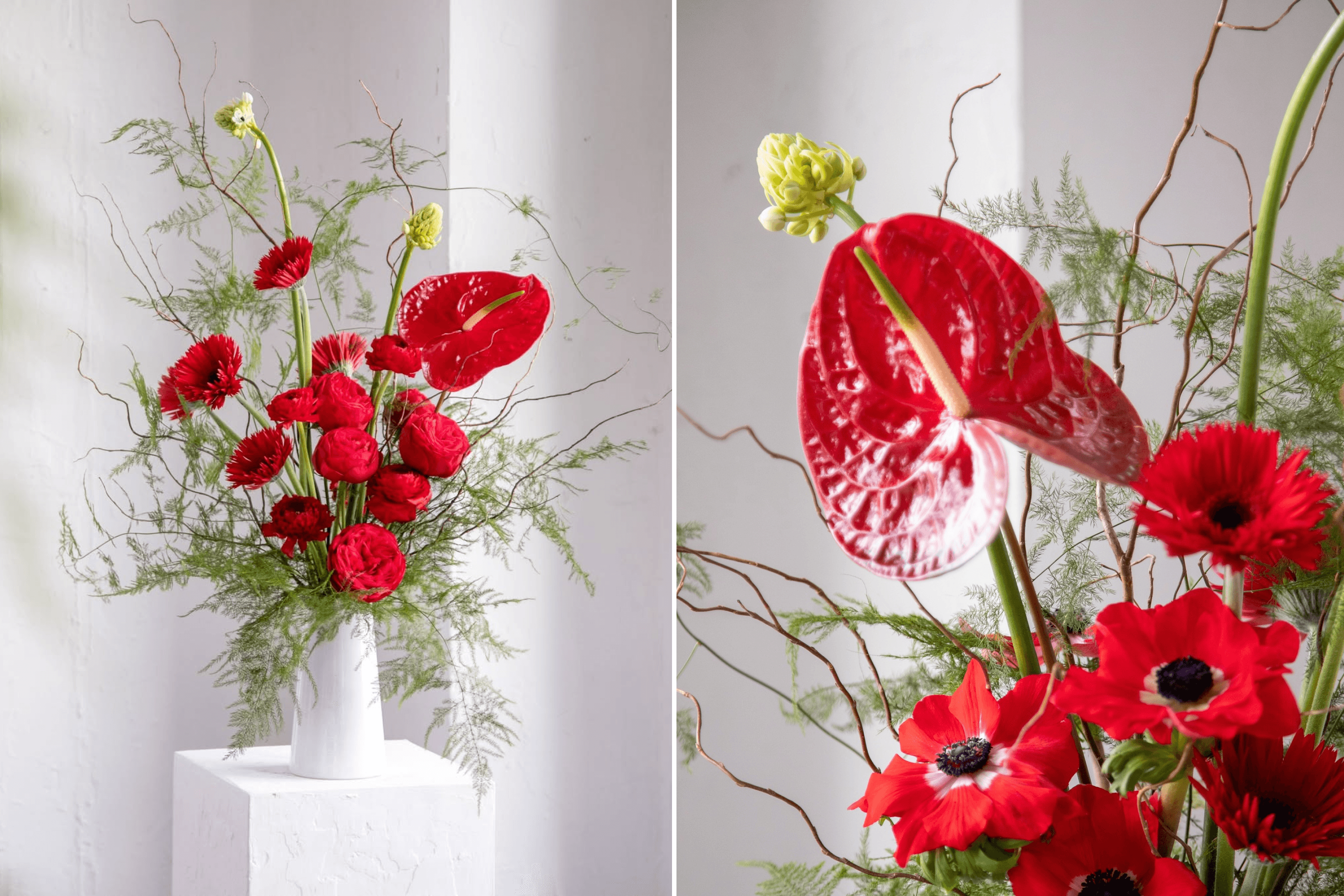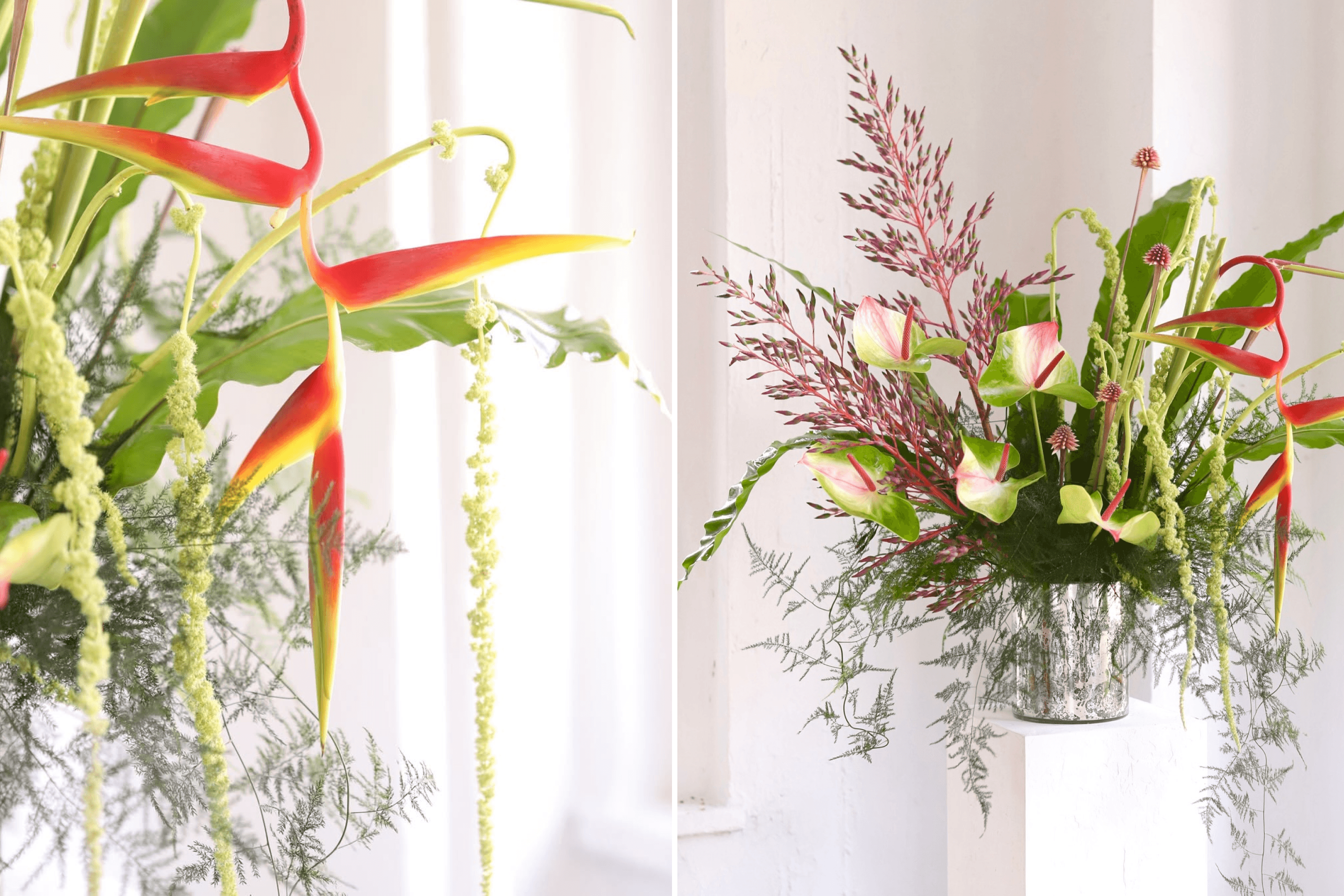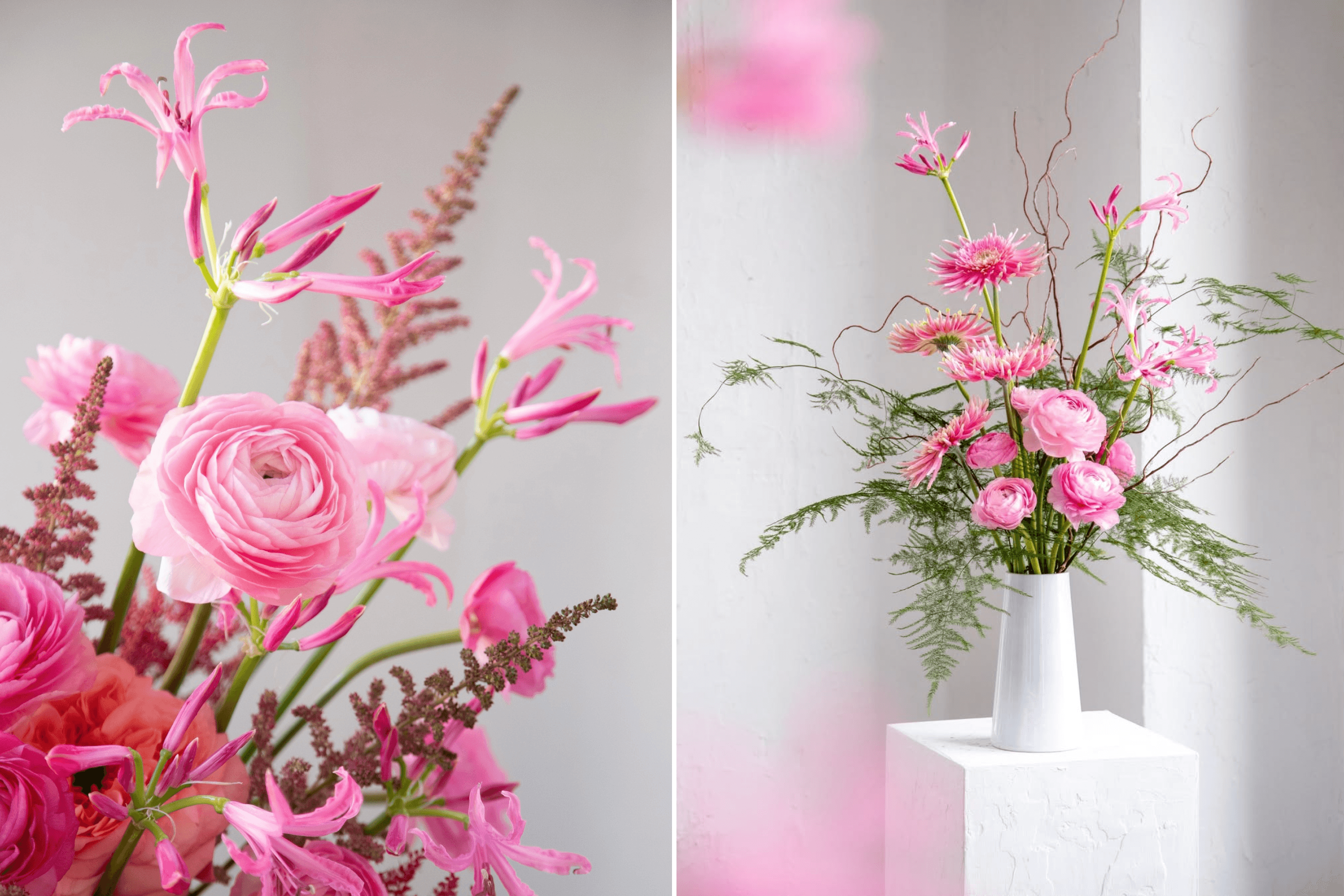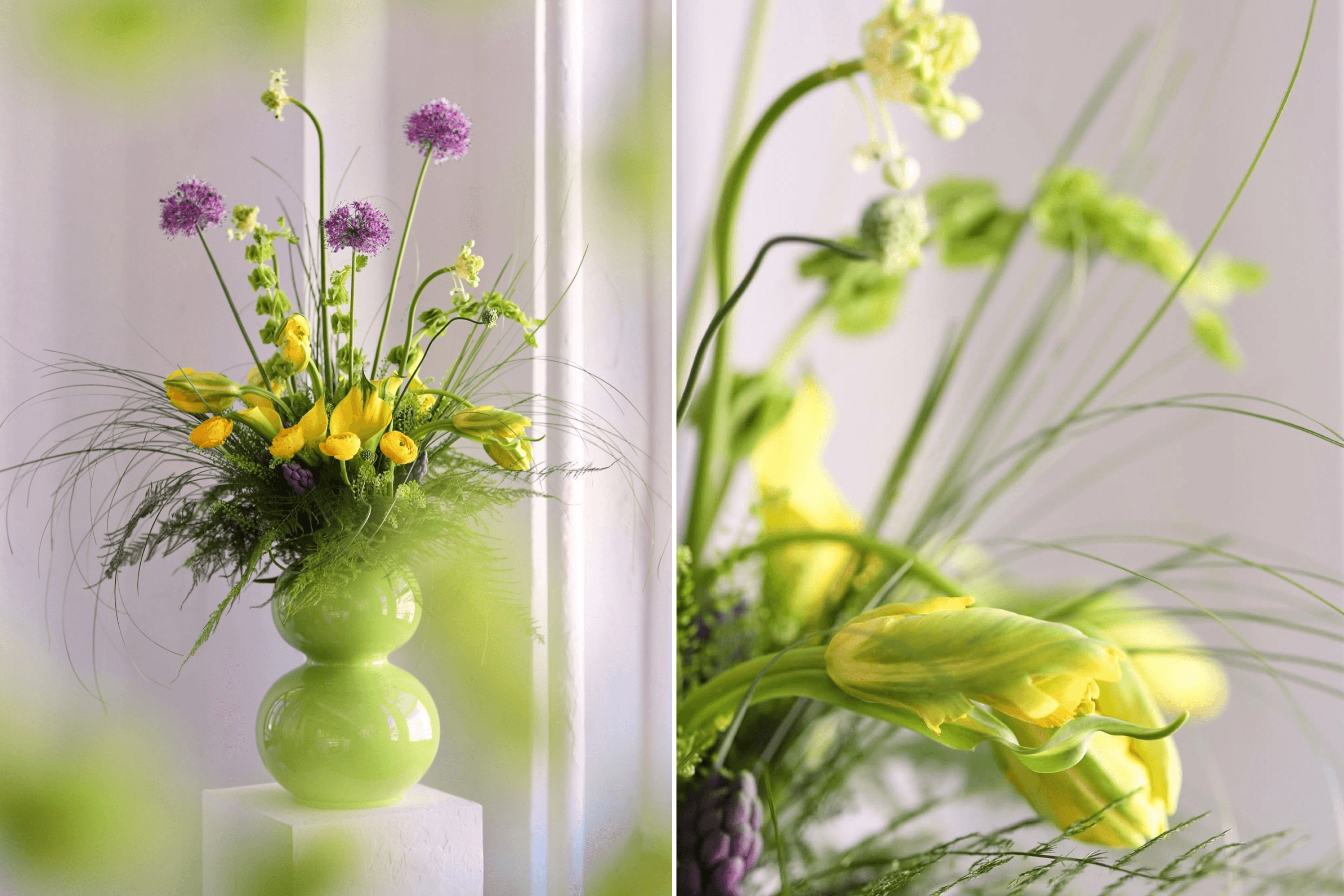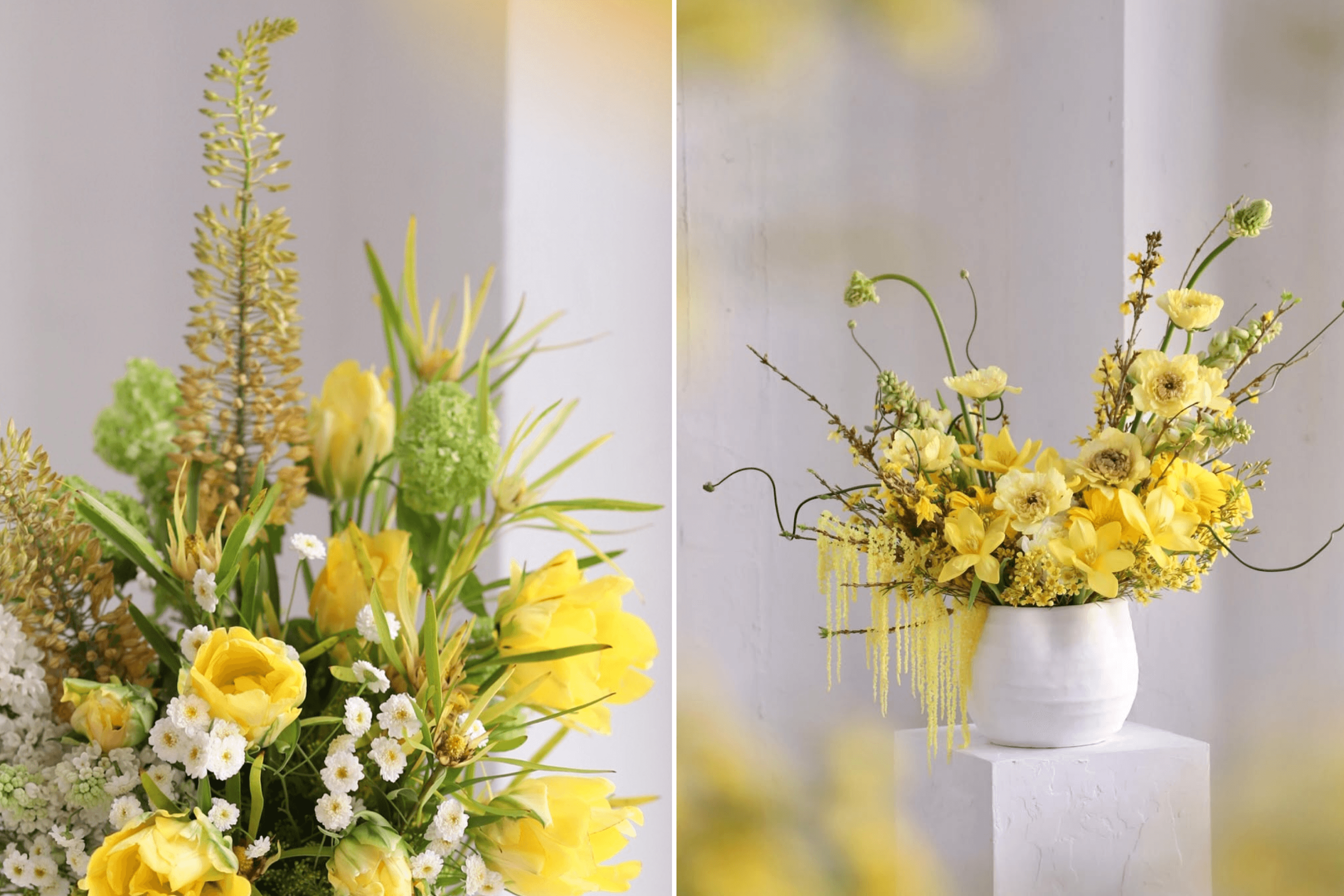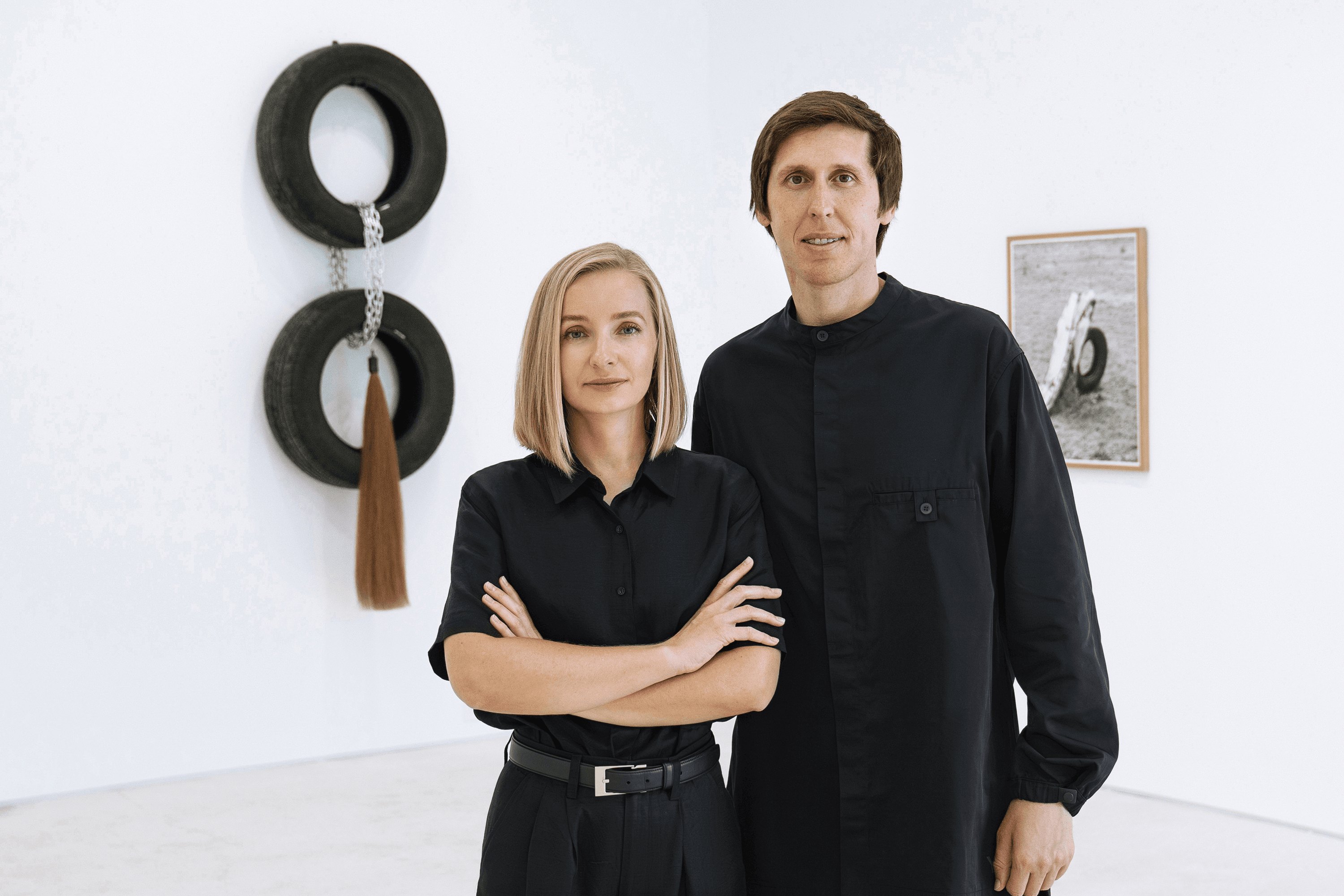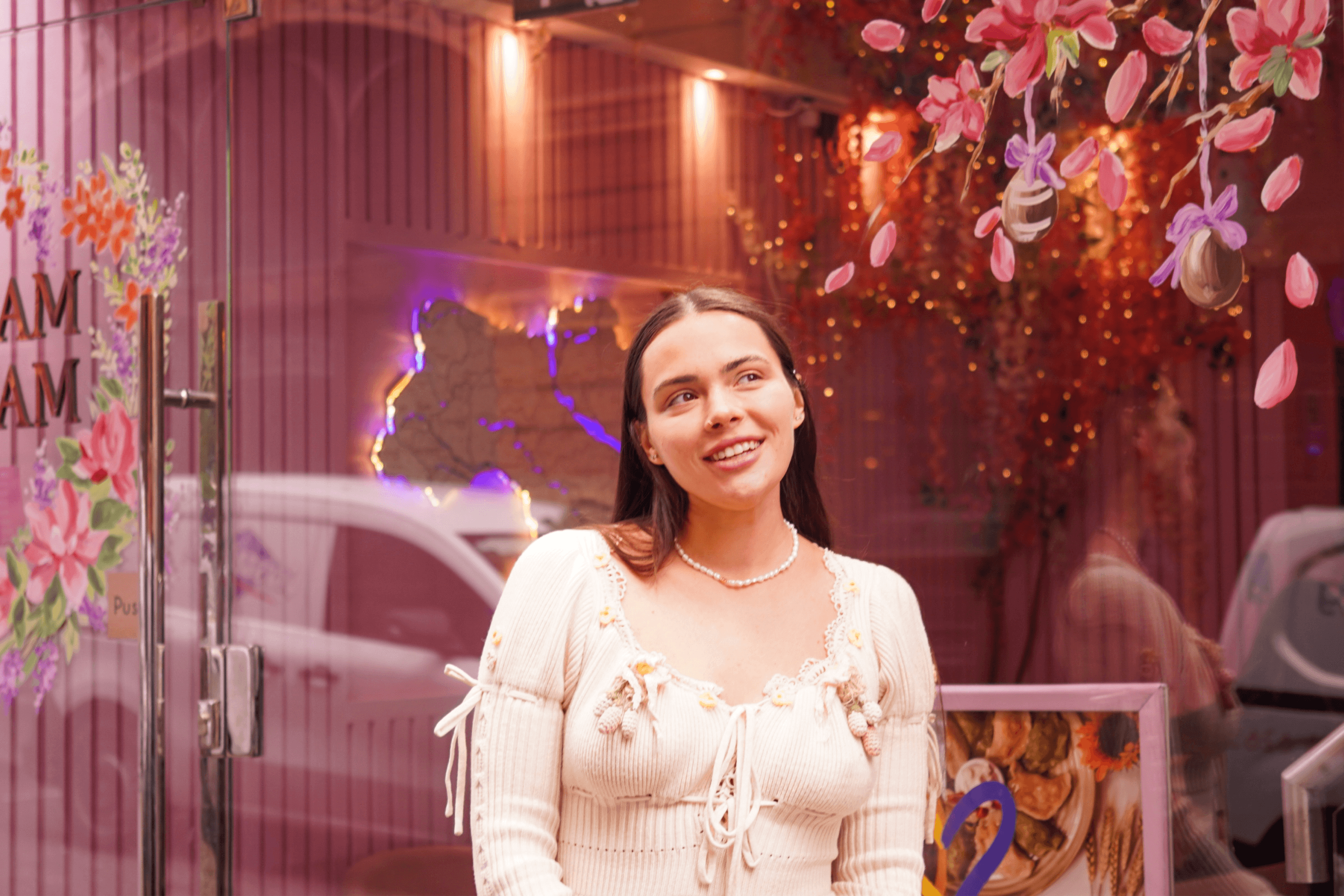35-year-old Ruslan Chyhryn is originally from Mariupol. He holds a degree in international logistics and worked for two years in the maritime security service at the Mariupol Commercial Sea Port. However, Ruslan unexpectedly found his true passion in the world of floral design and event decor. Starting with a local event agency, Ruslan moved to Kyiv in 2017, where he joined the well-known Farfor Decor studio (now called Mutabor Flower Service).
As a manager, he helped organize high-profile events for brands like H&M, Cartier, and Pandora while also lending a hand with floral arrangements. In early 2022, Ruslan was vacationing in Benidorm, Spain, when Russia launched its full-scale invasion of Ukraine.
He later made the decision to move to New York. There, he began working at local flower shops before launching his Instagram page, Buzok Flowers, in the fall of 2022. He started by creating custom bouquets, and by 2024, Buzok Flowers had its own studio in Manhattan, designing floral arrangements for clients such as Netflix, Selena Gomez, and Michelin-starred restaurants. Ruslan also runs a YouTube channel where he shares his insights on floristry and decor. Looking ahead, he plans to narrow his focus to curating elegant, small-scale events.
YBBP journalist Roksolana Rublevska spoke with Ruslan about building a floral brand in the U.S., what makes Ukrainian service stand out in the American market, navigating competition, and working with high-profile clients.
On discovering floristry and the move to New York
Ruslan, how did your sense of aesthetics come together? Was it always a part of you, or did you develop your eye and taste over time?
Visual exposure is everything when it comes to growing in floristry and decor. Social media, websites of top industry players — anything that trains the eye has been a huge help. But at the same time, I understand that seeing the bigger picture is something of a natural gift. Someone might glance at a candleholder in a shop and just walk by. But I already imagine how it’ll “come alive” at a dinner party, even if it looks plain or unremarkable at first. Or I’ll walk into a space filled with flowers and immediately know which ones I need for a particular bouquet. It’s not a random choice — it’s a clear vision.
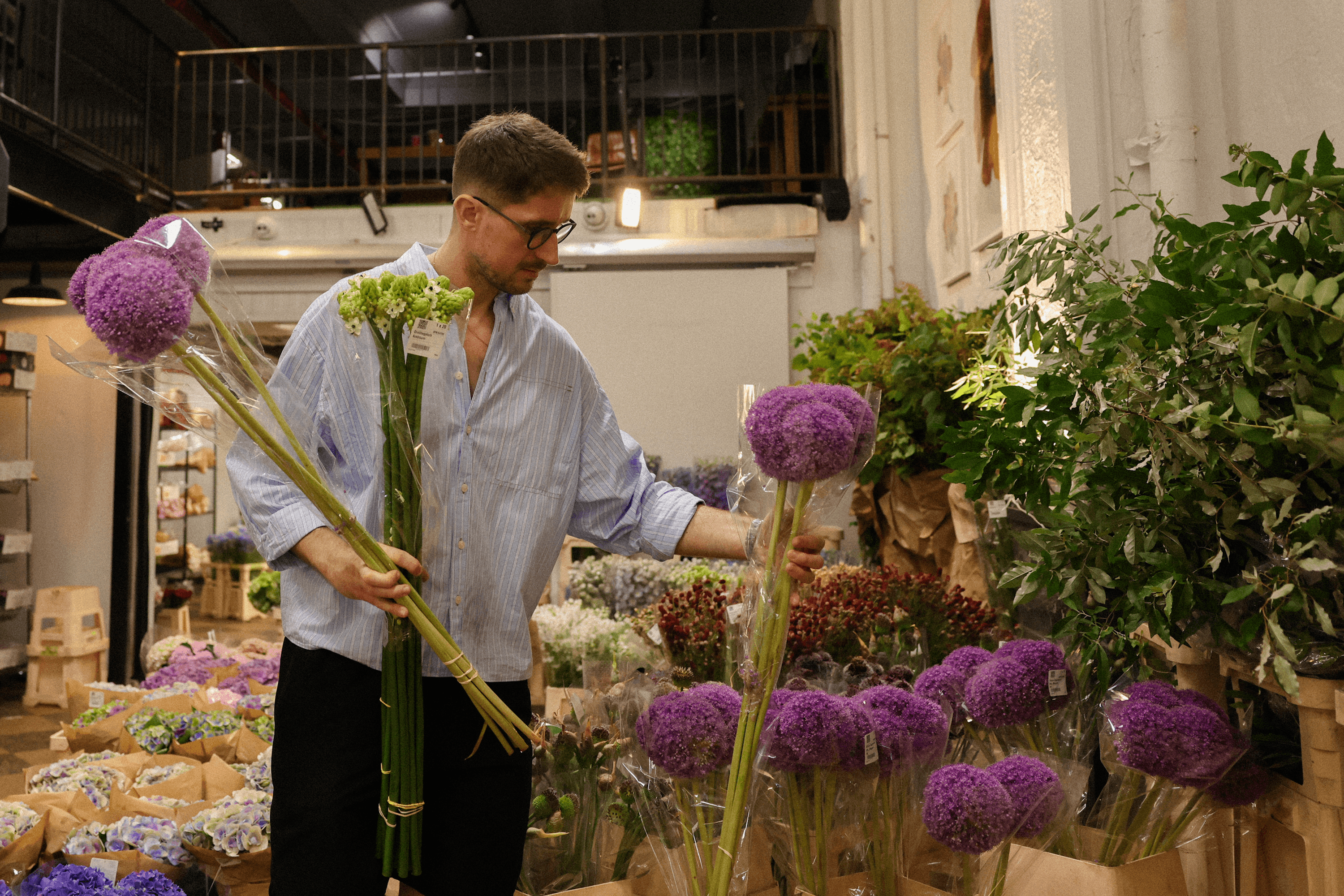
Why did you decide to move to New York and not stay in Spain?
I came to realize that my style of decor wasn’t really in demand in Europe. For weddings and celebrations, people in Europe often choose a beautiful location — a castle or a villa, and don’t invest much in design or decor. In the U.S., the event industry is more developed, and there’s a stronger focus on making a lasting impression. I hadn’t originally planned to move to the States, but a friend offered to help me apply through the U4U program — and I figured this was my chance.
What was your life like after moving to the U.S.?
Initially, friends offered me a place to stay for a week. Then I met up with a friend who had also worked in the event industry back in Ukraine. There’s a strong Ukrainian community in New York, and newcomers receive a great deal of support — people are generous with their information and genuinely help one another. The biggest challenge was finding a place to live without a credit history. But my friend, another guy, and I teamed up and found a three-bedroom apartment. Places like that can be tough to rent out, so the realtors were actually willing to meet us halfway — they agreed to rent it to us without a credit score or a mountain of documents.
When did you start working?
Right away. I got a job as a manager at a flower shop run by a Ukrainian woman. But like before, I wasn’t just managing — I was still designing floral arrangements, coming up with creative concepts, shooting content for social media, and finding the right vendors. My English was average at the time, but I had a Ukrainian colleague who helped with client communication. At the same time, people started reaching out through word of mouth, and I began taking private orders from home: I’d order flowers based on specific requests and arrange them in my apartment. In New York, many entrepreneurs here start out working from their bedrooms.

How did you get your name out in New York?
In October 2022, I created an Instagram page Buzok Flowers and started posting photos of my work. There weren’t many at first, but I made sure to post consistently. People were ordering bouquets and small event arrangements. Most of my business came through word of mouth, and I also paid for some Instagram ads myself. As the number of orders grew, I needed to start invoicing clients properly. So in January 2023, I registered an LLC and left my previous job to work at a fully American-owned flower shop. I wanted to see how the floral industry operates from the American perspective. At that time, I was earning $21 an hour.
What was different about the American way of doing things, and what did you take away from that experience?
Everything there worked like McDonald’s — simple, standardized, and predictable. First of all, everyone had a clearly defined role. If you’re a florist, you don’t handle deliveries or take orders, unlike in Ukraine, where people often wear many hats. Second, all the prep work was done in advance: bouquets followed specific “recipes,” and flowers, boxes, and cards were all prepped in advance. And third, it was all about speed and coordination — everything was packed like on an assembly line, and customers got their orders right on time. Meanwhile, Buzok Flowers was growing fast — more and more orders were coming in. In August 2023, I decided to leave the shop and focus entirely on my business.
Why did you go with the name ‘Buzok’? It sounds very Ukrainian and might be unclear to an American audience.
Of course, “buzok” means “lilac” in Ukrainian. But in American slang, “buzz” can mean something cool or exciting, and “ok” is… okay, an agreement. Ultimately, the name struck the right balance — it retains a Ukrainian feel while still being somewhat familiar to Americans.
How did you go from taking home orders to opening your studio?
I was already doing wedding decoration, all from home at first. Then one day, I was walking through the Flower District and spotted a sign: “Studio for Rent.” Then one day, I was walking through the Flower District and spotted a sign: “Studio for Rent.” The place had everything — a large flower cooler, specialized equipment like buckets, a worktable, and storage space. A florist had worked there before. As the number of big orders continued to grow, I decided to take a risk and rent it. My friend Volodymyr, who’s also from Mariupol, became my business partner. On September 22, 2024, we moved into the studio and started working from there.

You run the business together, but your partner Volodymyr prefers to stay behind the scenes — you’re the public face of Buzok. How do you split responsibilities?
I handle the creative side — from concepts and ideas to working with flowers, designing arrangements, and sourcing freelance florists and decor vendors. Volodymyr is the co-founder of the company. He takes care of the admin and all the paperwork.
How much did it cost to rent the studio and launch the business?
When we heard the price, we were pleasantly surprised. Just $4,000 a month for 1,000 square feet. That’s pretty reasonable by Manhattan standards. All in all, we needed about $30,000 to get things off the ground — money we had earned while already living in the U.S.
Do you present Buzok as a Ukrainian business in New York, or more of an American one now?
We see it as an American business with Ukrainian roots. That’s part of what makes us different — we bring a distinct Ukrainian standard of service to our American clients. In the U.S., people don’t usually overthink the details. If someone orders flowers for an event, they’ll often just get dropped off, and it’s left to the bartenders or servers to set them out. How they’re arranged is a different story. We do it differently — we go to the venue ourselves and make sure every element looks just like it did in the presentation. That’s our standard. And it also gives us a chance to capture great photos and build quality content afterward.
What were the biggest challenges you faced starting a floral business in New York?
The biggest challenge was the high level of competition. In the U.S., most hotels and restaurant groups work with florists on long-term contracts — a year, five years, sometimes even twenty. Take The Plaza Hotel, for example, where Home Alone was filmed, they sign floral contracts that last for decades. So, breaking in isn’t easy. You either need to offer something unique or try to compete on price, and undercutting the market usually isn’t sustainable in the long run.
How did you adapt to that kind of system?
We found our niche — intimate events. Things like dinners and brunches for 20 to 30 people, birthdays, small weddings, and brand presentations. These clients are more open to creativity; they’re not just after “mountains of flowers” like you’d see at a traditional wedding. That kind of approach is much more in line with my vision.
What helps you stand out in such a competitive market?
Experience and a deeper level of involvement. I don’t just drop off flowers. I often help shape the whole look and feel of an event, even though it’s technically outside my scope. I pay attention to the little things, offer suggestions to decorators, and offer ideas to elevate the atmosphere. That kind of care builds trust and helps create a base of regular clients. Most American florists keep it simple and practical. Their focus is on speed and cost: ten minutes per bouquet. At our studio, every arrangement is a design piece. I can easily spend up to 40 minutes on a single bouquet.
On clients
Which brands or big names have already reached out to you for event styling?
We’ve worked with Netflix — we did the floral arrangements for their New Year’s party through a contracting agency. We also did flowers for a product launch by Selena Gomez’s beauty brand. And Atomix, a Michelin two-star restaurant, is among our regulars.
How do clients like these find you?
Mostly through Instagram. Their managers either reach out in DMs or send an email. With Netflix, a producer’s agency contacted us directly. For the Gomez event, it was her manager who reached out.
What kind of budget do these projects run on?
The Netflix project was about $8,000. It covered florals for the bar and cocktail tables. Pricing mostly depends on the scope, but in terms of floral design, this is a solid case.
Who is your main client base — Ukrainians or Americans?
Most bouquet orders come from Ukrainians and clients from the post-Soviet community. But when it comes to events, it’s almost always American clients.
Have you personally faced any negative reactions on social media because of your work?
In the U.S., political and religious contexts are quite sensitive, particularly around the Israeli–Palestinian conflict. Our audience is mostly American, but it includes many followers with a Muslim background. We received a noticeable reaction after posting photos from a Jewish wedding — about 80 people unfollowed us in one day.
To us, it was just a beautiful celebration and a chance to share some elegant shots that showcased our work. But we realized that not everyone views such images neutrally. We can’t turn down clients based on their religion or background — our business is rooted in quality service for everyone, no matter their faith, culture, or nationality.
Who is your core audience — private clients, corporate customers, event agencies? How does your client base break down?
The majority of our clients are private individuals, particularly brides who find us through Instagram. They’re the ones who usually reach out directly and often suggest to their event planners that they work with us.
Event agencies are a tougher system to break into. It’s a pretty closed-off network, and many of them already have trusted vendors they’ve worked with for years. Planners usually want full control over the process, and that includes picking their florists. So, they’re often hesitant to take a risk on someone new. But when they see the level of service and care we offer, their perspective changes, and some even reach out to us for future projects.
We also have a few great partnerships with restaurants. When a client comes to them looking to host an event, they often recommend us. We act as their official florist and handle all floral arrangements on-site.
Overall, our client base breaks down like this: around 70% are private clients (mostly brides), 20% come through restaurant referrals, and about 10% from collaborations with event planners. But we’re actively working on growing our partner network.
How many restaurants do you work with regularly?
We currently work with three restaurants. One of our key partners is Atomix, a Michelin two-star restaurant in New York. The second is Naro, located in Rockefeller Centre, and the third is ACRU, right in the heart of SoHo. We handle floral arrangements for their events and also take bouquet orders placed through those venues.
As for the corporate segment, we supply several luxury residential buildings that order fresh flowers weekly for their lobbies and conference rooms. At the moment, we’re supplying three of those properties.
Lately, there’s been talk that attitudes toward Ukrainian businesses abroad have changed — at first, there was a lot of support and empathy, but now people sometimes seem indifferent or even annoyed. Have you felt that shift in your business?
Yes, this is something we’ve definitely experienced. There was a huge wave of global support for Ukrainians and Ukrainian businesses, at the beginning, a strong wave of solidarity. But over time, like in any society, fatigue and even irritation set in. We often hear things like, “We’re giving you so much money, and now you’re taking our jobs.”
But here’s the truth: we’ve never received any financial aid. Everything we’ve built, we built on our own, with our effort and resources. The only support we got was work authorization in the U.S., which allowed us to work legally. That’s it. No grants, no funding. And we’ve always been transparent about who we are — we proudly represent ourselves as a Ukrainian brand. We’ve never hidden our background.
Is it true that American clients are more frugal than Ukrainian ones?
They’re more money-conscious, and it shows right away. American clients expect full transparency. Every line in the quote needs to be clearly listed, with no hidden costs. That said, they’re usually not concerned with the exact number of stems that go into an arrangement — they just want to see which flowers will be used. That’s just how the market works here.
Even in everyday situations — like grabbing a coffee at Starbucks — they’ll say, “That’s a bit pricey.” For them, flowers are more of a luxury than a necessity. They carefully consider whether a floral order is something they actually need.
Do walk-in clients ever come to your studio just to buy a bouquet on the spot?
They can, sure, and if we’ve got flowers on hand, of course, we’ll sell them. But in the U.S., the walk-in culture isn’t very developed. Most businesses operate by order, and the majority of sales happen online or through event planners.

Having an open-door studio is more about image and self-branding. From a business perspective, it’s not essential as clients want fast, convenient delivery rather than browsing in shops. We do have a listed address and can be found on Google. Occasionally, people stop in — but it’s rare, only a few times since we opened. So if someone’s thinking of starting a floral business in New York, you can do it without a storefront — from home or a warehouse setup.
On money
When did the business become self-sustaining and start generating profit?
We only opened the studio in September 2024, so it’s still too early to talk about year-over-year performance. For now, all profits are going straight back into the business.
What’s the studio’s average monthly net income?
As of September 2024, our income allows us to cover our main costs: rent, salaries, and day-to-day operations.
How is the budget typically divided between flower purchases, wages, rent, and materials like paper or fabric for arrangements?
For events, flowers take up roughly a third of the budget. For bouquets, flowers account for about half of the total budget.
What’s your profit margin like? For bouquets, how much of the cost goes into flowers, fabrics, and decorative pieces?
Right now, we use a markup coefficient of 2.5.
And where does most of your revenue come from?
Our biggest part of our income definitely comes from the B2B segment, not from bouquet sales.

How much does a typical wedding setup cost?
An average event with 10 tables and 200 guests, including floral decor like the ceremony arch, bridal and bridesmaids’ bouquets, and table arrangements, costs around $10,000. If you add extras like photo zones, floral aisles, or hanging installations, the price increases significantly.
And how many projects do you usually do per month?
We handle two smaller projects a week, like dinners or birthday parties for 20–30 people, right now. And one large event a month, usually a wedding or something on a bigger scale.
On flowers
Have your floral tastes and design style changed since moving abroad? What inspires you these days?
At first, I was inspired by New York itself — its energy, style, architecture, and diversity. I started drawing inspiration from travel and the work itself. This profession requires a lot of movement. Ideas often come through the challenges, too: the American system is very straightforward, so I often have to find creative ways to explain that “I need it done differently.”
Where do you buy your flowers? How often do you restock, and how much typically goes to waste?
We order through international flower auctions, they arrive from all over the world: the Netherlands, Ecuador, and Africa. Our main supply comes in every Monday, which covers our retail needs and standard orders. But since our bouquets are personalized, we’re constantly picking up extras from the local Flower District, which is just around the corner from our studio. That gives us the flexibility to customize and respond quickly to client requests.
When it comes to projects like weddings, everything in the U.S. is planned well in advance, so we have enough time to place orders for exactly what we need. We usually time deliveries so that the flowers arrive 2 to 3 days before the event. That way, they have time to soak up water, bloom properly, and be ready for use.
Do you work with seasonal flowers or stick to the same varieties year-round?
Flowers are definitely seasonal, they become available depending on the time of year. I enjoy visiting flower farms from time to time. For instance, dahlias are in season in September, and we source them from local farms rather than importing them.
Do you keep your flowers in just water? What helps them last longer?
We do keep them in water, but with certain floristry techniques. For example, chrysanthemums sit in little mesh nets to slow their blooming, and peonies are stored closed. Sometimes we even keep roses out of water for 3–4 days to hold back their growth, then rehydrate them just before the event so they open beautifully. These techniques help us stay in control of the condition of the flowers.
The main reason our flowers last longer is that we use a professional floral cooler with controlled temperature. This slows down the blooming process. Flowers don’t last nearly as long at home without that kind of environment.
Do you add any special powders or solutions to the water for your flowers?
We used to use Chrysal, a special flower food powder that helps maintain freshness. But we’ve moved away from it. Once flowers “get used” to that kind of additive, they need it constantly. In reality, most people replace the solution with plain water, which causes the flowers to wilt faster. Now, we store our flowers in a floral cooler with plain water. That gives us a solid 3 to 4 days of life without any additives.
What happens to leftover flowers? How do you dispose of them?
For event projects, we do our best to use every last stem — the flowers are already bought, and it feels wasteful to throw them out. Sometimes we place extra flowers in washrooms or other spaces. We usually try to add more flowers to our arrangements, so we hardly ever throw anything out. That’s more of a rare case than the norm.
If anything’s left and still in good shape, I’ll either use it for content or send a bouquet to an influencer. I understand that by the end of the week, no one’s likely to buy them. We even add QR codes so people can scan, see our work, and share it on social media. It’s a way to promote the brand and make the most of every flower.

Do you mostly hire Ukrainian florists when you freelance out work?
Yes, we do. Ukrainian florists have a strong sense of style and work for the result, not just clocking hours. They genuinely care about making things look beautiful. If you want to book a great Ukrainian florist, you need to plan months ahead — they’re absolute gems in this industry.
Do you bring any Ukrainian influences into your creative approach?
Not really, we mostly follow global trends. What’s in style internationally is also popular in both the U.S. and Ukraine. If a client asks for something “with a Ukrainian touch,” of course, we can incorporate elements of national identity.
Do you face any difficulties delivering so carefully designed bouquets without them getting damaged?
All the time. I’m constantly working on finding the right balance between design quality and logistics, like opting for more careful couriers or designing slightly more compact bouquets that keep their style but are better suited for standard delivery. But New York is so diverse that every studio can find its niche, and clients who appreciate this kind of thoughtful approach.
On your website, you mention that your style lies at the intersection of design, floristry, and subculture. What does that look like in practice?
We incorporate elements from the latest global fashion trends and runway shows. By “subculture,” we mean people who understand new trends and have their unique sense of style. For example, I loosely refer to them as “hipsters” — people who look different, non-traditional. They’re not running the world, but they’re definitely pushing it forward. These are the ones shaping trends, appearing in magazines, working in companies that build concepts. That’s the kind of client we’re designing for.



